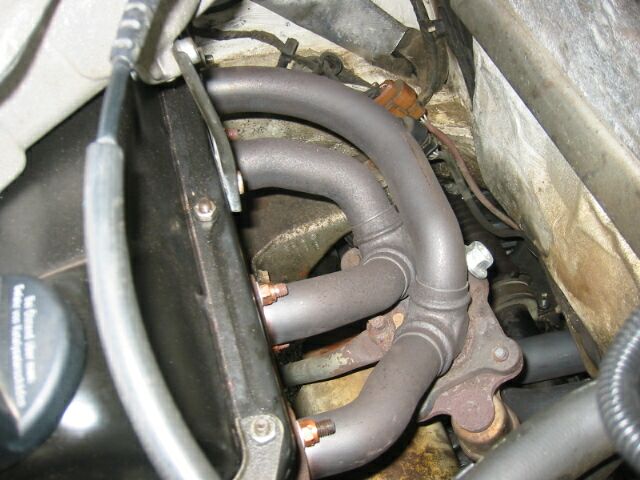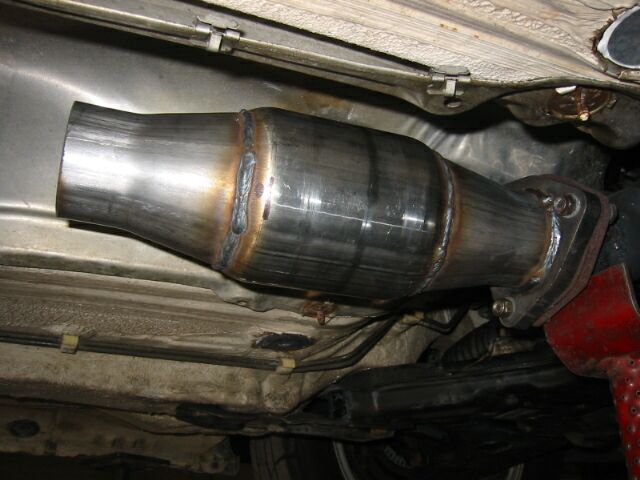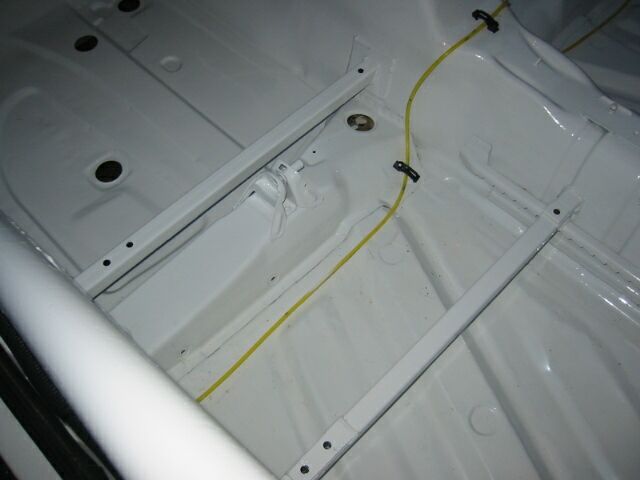Improving
Improved Touring
Off-season Upgrades
Winter 2004 -
Spring 2005 |
It
is officially the off-season and time to continue development of the PhilsTireService.com
Team GTI. We have a number of improvements planned and progress will be
documented on this page. We haven't prioritized or budgeted completely but
the list of likely modifications is substantial:
>>
Transmission
- lower final drive gear ratio, limited slip differential, maintenance
rebuild, and ring-gear bolt kit - Done
>>
Engine - IT-spec
rebuild with raised compression, replacement of service parts, and optimization
of internal parts (balancing and blueprinting)
>>
Engine Management
System - research continues on what changes might be incorporated in
the fuel injection and ignition systems - Begun,
probably won't ever be done!
>>
Intake and
Exhaust - street-legal exhaust system with muffler, race-spec catalytic
converter, and aftermarket header - Done
>>
Suspension
- additional adjustable rear antiroll bar, revised spring rates and
alignment, wheel spacers, and camber plates - Partially
done
>>
Cockpit
- upgraded instrumentation, improved mirrors, and a driver's foot well
plate with dead pedal rest -
Partially done
>>
Brakes
- removal of all ABS system hardware, re-plumbing of hard lines, and
addition of a balance proportioning valve -
Done
>>
Safety - installation
of an onboard fire system and upgraded rollcage padding - Done
|
This
is the improved seat mount fabricated by Competition Cages. The multiple
holes facilitate installation of a choice of two Recaro race seats, depending
on the size of the driver running the car.
The driver foot well
needed to be repainted after 13 hours of abuse at the VIR enduro, and
4 hours of testing the day before that event. The gritty VIR paddock dirt
acted like sandpaper under the drivers' feet, taking the finish down to
bare steel in places. An aluminum floor plate is planned to prevent this
problem in the future.
That yellow plastic
tube is part of the vacuum-actuated central locking system - one of the
compromises on competitiveness yet to be removed from Project GTI. |
|
The
lower seat mount and a thinner bottom Recaro cushion made the quick-release
hub used last season unnecessary, and allowed installation of the original
horn button.
Doesn't your race
car have floor mats? That item actually comes out for race events but
keeps the interior clean while the car is being worked on.
Also visible here
is the black, textured ABS plastic dash panel cut to fit the space originally
occupied by the radio. Switches for the enduro auxiliary lights are mounted
here. |
 |
The
hand-held Halon extinguisher has been augmented with a 5-pound on-board
fire system, also using Halon extinguishing agent. This is a push-release
type system, so the trigger button and cable mechanism must be mounted
handy to the driver and on a sturdy bracket - in this case, the piece
that originally supported the interior center console. Release cable routing
is also important, with large bend radii to prevent binding.
The hand-held unit
is retained for incidental fires outside of the car - like sometimes happen
when dry grass is ignited by a hot exhaust, under a car stuck out on course.
Interior wiring has
also been rerouted and bundled out of the way. It is not permitted to
simply remove unused wires under the Improved Touring rules, although
the stock antilock brake sensors and passenger compartment wiring have
been removed.


Click image for
installation detail photos |
 |
Chief
technician Cameron Conover of Greensboro, NC replaced the stock exhaust
manifold with this original-equipment fabricated tubular unit out of a
New Beetle. It is a direct bolt-in replacement for the original cast iron
lump (below). While only dyno testing would prove that it makes more power,
it sure seems to be a better design.
In addition to being
4.5 pounds lighter than the original part, this manifold should be stronger
than an aftermarket racing header - an important consideration on a car
that runs rallycrosses, endurance events, and for the first time this
season, a tarmac rally

Click image for
full-size image of the old manifold
A custom chip was
also installed in the GTI's electronic control unit (ECU), recurving and
advancing the timing, and increasing the rev limit from less than 6000
all the way to 7500rpm. The engine may not make more power at those higher
revs but it will give the drivers more latitude of gear choice between
turns. |
 |
The
remains of the old exhaust system, most of which was hacked off at the
VIR enduro last Fall, have been replaced by a custom-made 2.25" system
built by J.R. Tire & Automotive of Creedmore, NC.
One interesting feature
of the system is the compact, high-flow catalytic converter installed
to replace the original unit (below). It incorporates both O2 sensors,
preserves the Golf's road license status, and - as an unanticipated bonus
- results in a cooler floor, due to increased air space in the tunnel.

Click for a full-size
image of the old catalytic converter
The system also incorporates
a muffler (not pictured) that quiets the car sufficiently for on-road
use, like rally transit stages. Randy of J.R. Tire & Auto engineered
a flange separation that allows the rear exhaust section to be easily
removed and replaced by a simple turndown pipe, for roadracing events
where the minimum sound threshold is sufficiently high. |
 |
We
took advantage of an open Saturday afternoon and fabricated this floor-plate/dead-pedal
unit, out of .063" aluminum tread plate.
I guess that we could
have not used the polished stuff but who can resist a little bling on
a race car?
PS - On-track
data acquisition testing strongly suggests that the GTI is faster with
the new muffler than it is with just the turndown! It will take actual
dyno testing to get quantitative data so stay tuned for more. |
 |
We
finally have a proper Improved Touring-spec gearbox in Project GTI, combining
the better acceleration afforded by a 3.94:1 final drive gear set (from
a MkII Diesel VW Golf), and a limited slip differential (LSD), manufactured
by KAAZ in Japan and sold in the US by Bildon
Motorsport.
The transmission was
assembled by Charlotte-area VW gearbox guru Geoff Zimmer. Feel free to
contact us by email if
you want to get in touch with Geoff about work on your 020 or other VW
'box.
The function of a
LSD is to force both front wheels to drive the car forward. With the stock
"open" diff, the car turns easily as the differential gears
allow the wheels to spin at different speeds, but the car tends to spin
one wheel when accelerating hard - particularly out of corners, where
the inside, unloaded wheel just whizzes away.
The numerically higher
- but "lower" ratio - final drive (FD), makes the car slower
in all of the gears than it would be with the original 3.86:1 FD. However,
this makes the car accelerate more quickly, decreasing lap times, by the
same action that lets all cars accelerate more quickly in low gears than
in higher gears.
|
 |
It's
not much to look at but the new brake master cylinder, junkyard vacuum
booster, and used fluid reservoir replace the much heavier and more complicated
equivalent parts that came with the stock GTI antilock brake system.
Note that the front
left port on the master cylinder is plugged (the bright fitting on the
right in the image). One line comes off of the other front port and runs
to the back of the car, through a driver-adjustable proportioning valve,
to a tee junction, and then to each rear brake caliper.
Project GTI has also
received extensive service in preparation for the Summit Point 12-hour
endurance race, scheduled for the first weekend of June. |
 |
Since
Project GTI ran originally in Showroom Stock trim, it was required that
we use the stock alloy wheels. They were fine, as far as they went, but
a switch to light alloy racing wheels will save a whopping 9 pounds per
wheel!
The Hoosier tires
illustrated here, as installed by PhilsTireService.com,
are also lighter than the Toyos that we've used to this point, and can
be expected to be marginally grippier as well.
We will debut this
package at the 12
Hours at the Point enduro, the first weekend of June. |
 |
Rear
suspension alignment has been modified with 1.5 degrees of negative camber
(where the wheels are tipped inward at the top), through the use of shims
from 247-parts.com.
These specially ground
parts fit behind the stub axle, and align the tire tread more optimally
with the track surface. This should make the rear tires wear more evenly
and last longer, particularly in enduro events
The only downside
to this change is that it provides additional grip at the rear end, aggravating
handling that has tended toward understeer. New rear spring rates are
expected to alleviate this situation. |
 |
| Next |
New
rear spring rates, additional service items, and the addition of accessories
to prepare the car for its tarmac rally debut in September. |
| Last
updated 8 May 2005
All photos K. Knestis unless otherwise noted |
Project
GTI is headquartered in Greensboro, NC |














